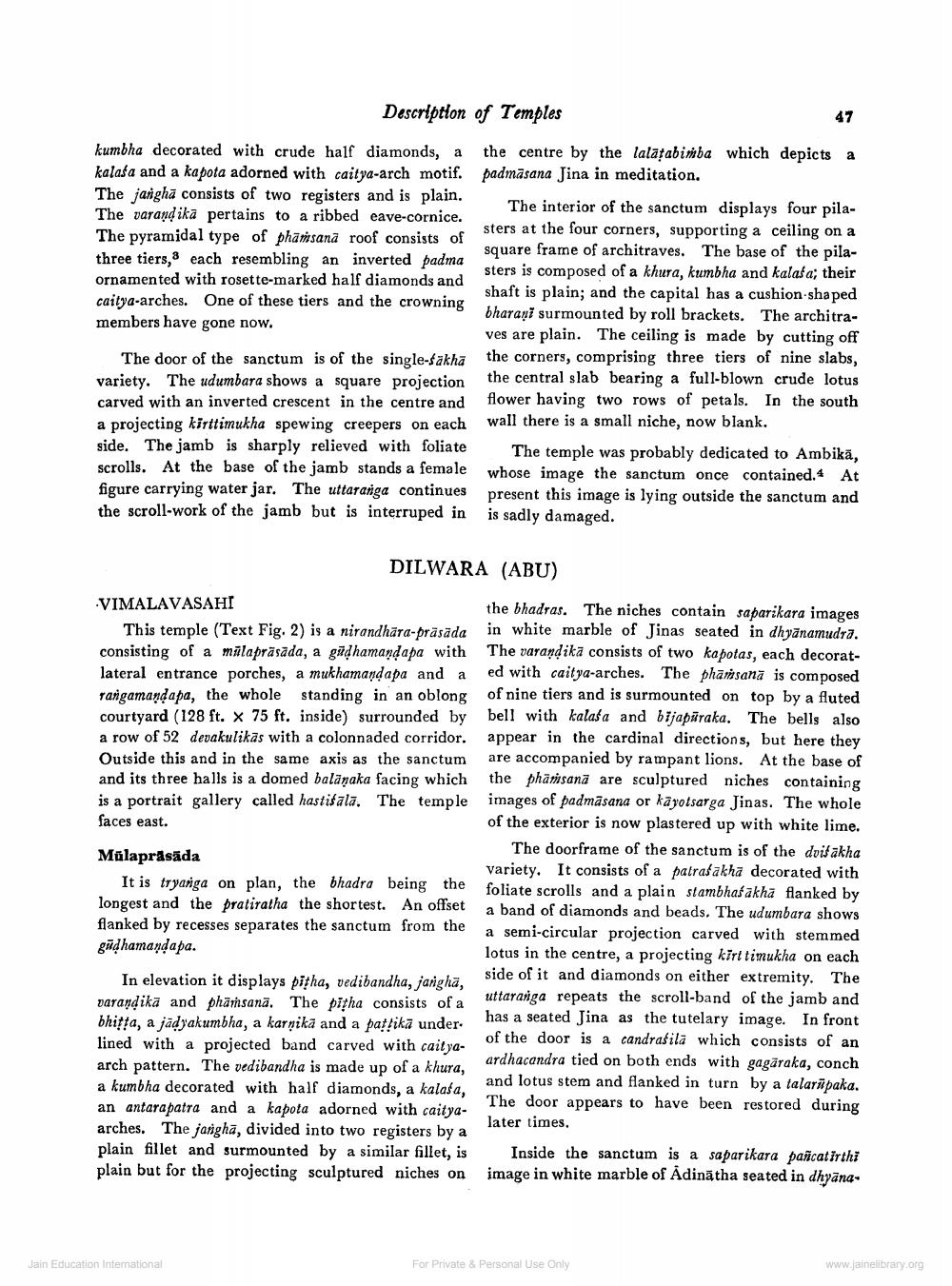________________
Description of Temples
kumbha decorated with crude half diamonds, a kalaša and a kapota adorned with caitya-arch motif. The jangha consists of two registers and is plain. The varandika pertains to a ribbed eave-cornice. The pyramidal type of phātisanā roof consists of three tiers, 3 each resembling an inverted padma ornamented with rosette-marked half diamonds and caitya-arches. One of these tiers and the crowning members have gone now.
the centre by the lalatabimba which depicts a padmasana Jina in meditation.
The interior of the sanctum displays four pilasters at the four corners, supporting a ceiling on a square frame of architraves. The base of the pilasters is composed of a khura, kumbha and kalaša; their shaft is plain; and the capital has a cushion-shaped bharani surmounted by roll brackets. The architraves are plain. The ceiling is made by cutting off the corners, comprising three tiers of nine slabs, the central slab bearing a full-blown crude lotus flower having two rows of petals. In the south wall there is a small niche, now blank.
The door of the sanctum is of the single-sakha variety. The udumbara shows a square projection carved with an inverted crescent in the centre and a projecting kirttimukha spewing creepers on each side. The jamb is sharply relieved with foliate scrolls. At the base of the jamb stands a female figure carrying water jar. The uttaranga continues the scroll-work of the jamb but is interruped in
The temple was probably dedicated to Ambikā, whose image the sanctum once contained. At present this image is lying outside the sanctum and is sadly damaged.
DILWARA (ABU) VIMALAVASAHI
the bhadras. The niches contain saparikara images This temple (Text Fig. 2) is a nirandhāra-prāsāda in white marble of Jinas seated in dhyānamudra. consisting of a malaprāsada, a gädhamandapa with The varandika consists of two kapotas, each decoratlateral entrance porches, a mukhamandapa and a ed with caitya-arches. The pharsanā is composed Tangamand apa, the whole standing in an oblong of nine tiers and is surmounted on top by a fluted courtyard (128 ft. X 75 ft. inside) surrounded by bell with kalaša and bijapīraka. The bells also a row of 52 devakulikās with a colonnaded corridor. appear in the cardinal directions, but here they Outside this and in the same axis as the sanctum are accompanied by rampant lions. At the base of and its three halls is a domed balanaka facing which the pharisana are sculptured niches containing is a portrait gallery called hastišala. The temple images of padmāsana or kayotsarga Jinas. The whole faces east.
of the exterior is now plastered up with white lime.
The doorframe of the sanctum is of the dvišakha Mülaprasāda
variety. It consists of a patrašakha decorated with It is tryaniga on plan, the bhadra being the foliate scrolls and a plain stambhafakha flanked by longest and the pratiratha the shortest. An offset a band of diamonds and beads. The udumbara shows flanked by recesses separates the sanctum from the a semi-circular projection carved with stemmed gūdhamandapa.
lotus in the centre, a projecting kirttimukha on each
side of it and diamonds on either extremity. The In elevation it displays pitha, vedibandha, jarigha, varandika and phamsanā. The pipha consists of a
uttaranga repeats the scroll-band of the jamb and bhitta, a jādyakumbha, a karnika and a patrika under
has a seated Jina as the tutelary image. In front lined with a projected band carved with caitya
of the door is a candrafila which consists of an
ardhacandra tied on both ends with gagāraka, conch arch pattern. The vedibandha is made up of a khura,
and lotus stem and flanked in turn by a talaripaka. a kumbha decorated with half diamonds, a kalasa,
The door appears to have been restored during an antarapatra and a kapota adorned with caitya
later times, arches. The jarigha, divided into two registers by a plain fillet and surmounted by a similar fillet, is I nside the sanctum is a saparikara pañcatirthi plain but for the projecting sculptured niches on image in white marble of Adinātha seated in dhyāna.
Jain Education International
For Private & Personal Use Only
www.jainelibrary.org




